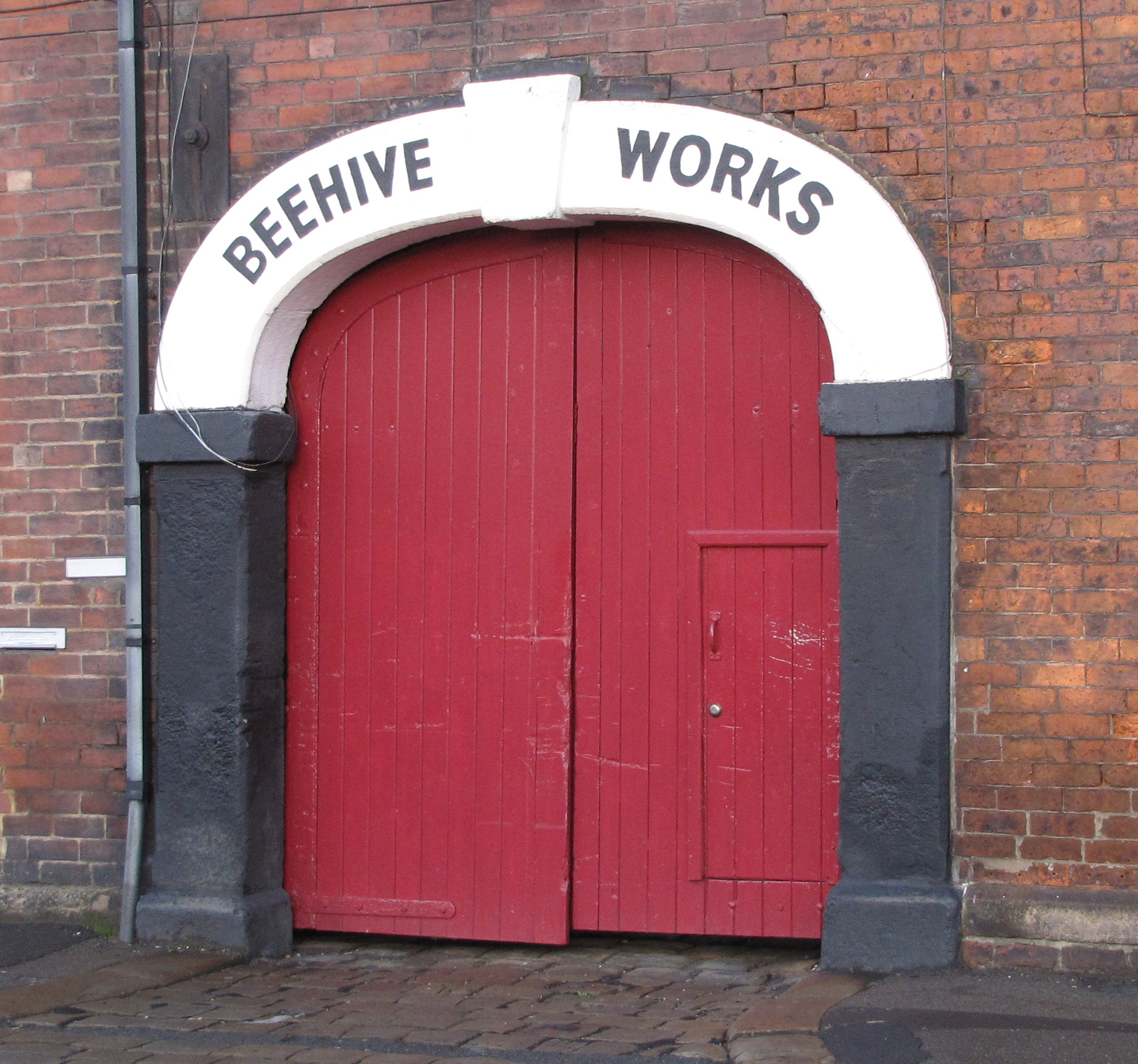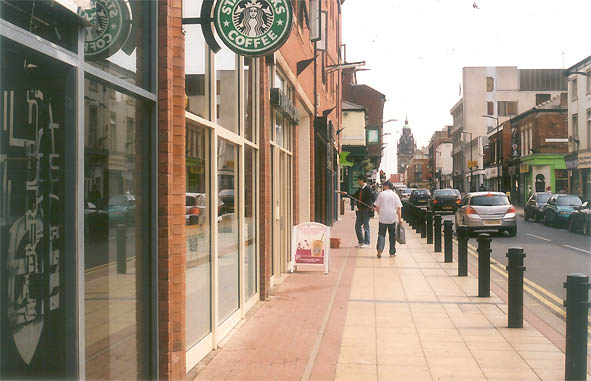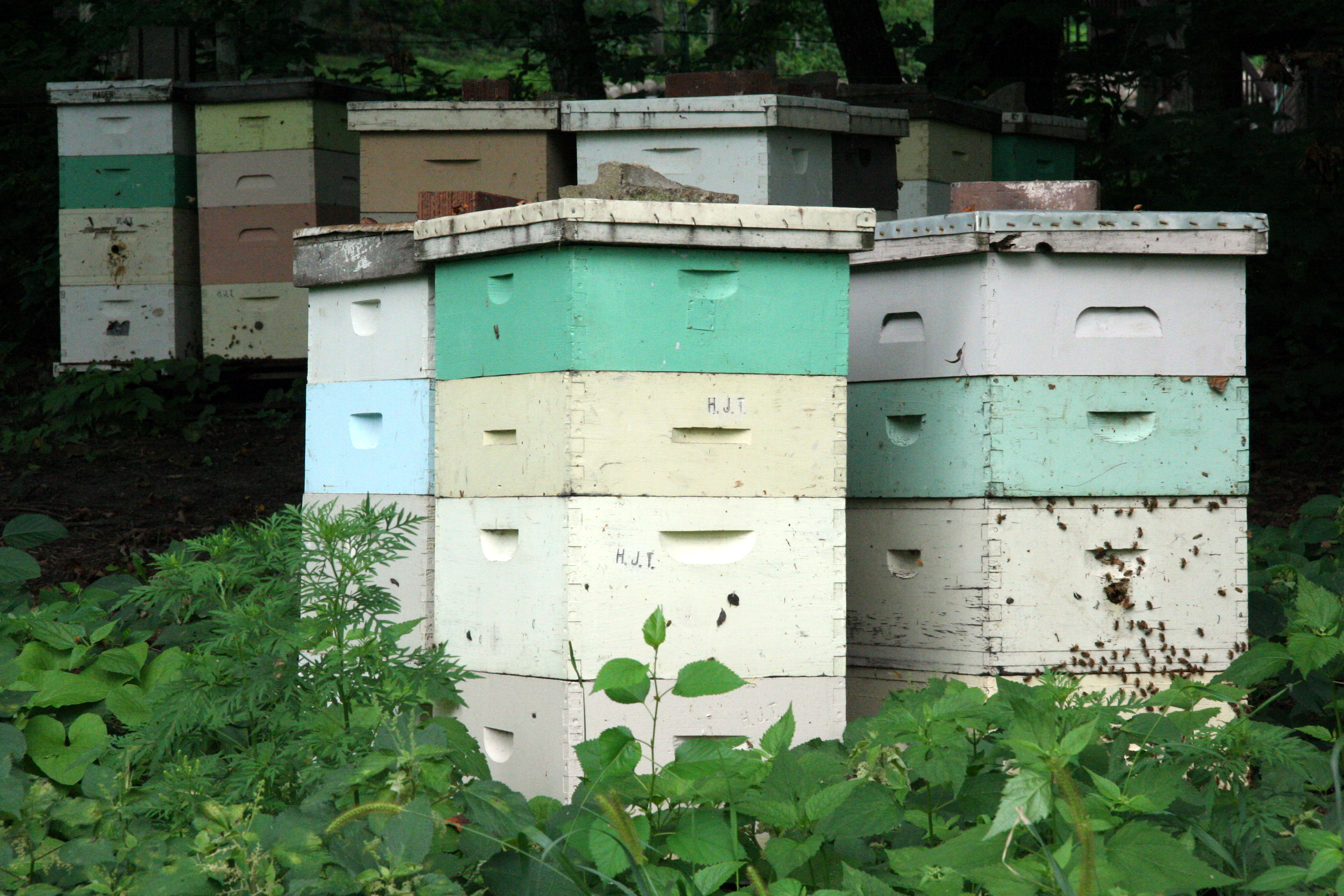|
Beehive Works
The Beehive Works are a purpose-built cutlery works located on Milton Street in the Devonshire Quarter area of Sheffield city centre. The works were built in stages in the second half of the 19th century and are designated as a Grade II* listed building with English Heritage stating that they are of special architectural and historic interest as an examples of buildings associated with Sheffield's metal manufacturing and metal working trades. The works stand adjacent to the Taylor's Eye Witness Works and together they make Milton Street one of the best places to gain an impression of Sheffield’s former cutlery industry. History It is thought that the first phase of building took place in the late 1850s or the early 1860s. The buildings were initially known as the Milton Works, with B. Mathewman and Sons being the first known occupants. The Works expanded quickly during the 1880s and 1890s with the addition of more grinding wheels and forges; the steam power plant was also enl ... [...More Info...] [...Related Items...] OR: [Wikipedia] [Google] [Baidu] |
Beehive Works
The Beehive Works are a purpose-built cutlery works located on Milton Street in the Devonshire Quarter area of Sheffield city centre. The works were built in stages in the second half of the 19th century and are designated as a Grade II* listed building with English Heritage stating that they are of special architectural and historic interest as an examples of buildings associated with Sheffield's metal manufacturing and metal working trades. The works stand adjacent to the Taylor's Eye Witness Works and together they make Milton Street one of the best places to gain an impression of Sheffield’s former cutlery industry. History It is thought that the first phase of building took place in the late 1850s or the early 1860s. The buildings were initially known as the Milton Works, with B. Mathewman and Sons being the first known occupants. The Works expanded quickly during the 1880s and 1890s with the addition of more grinding wheels and forges; the steam power plant was also enl ... [...More Info...] [...Related Items...] OR: [Wikipedia] [Google] [Baidu] |
Devonshire Quarter
The Devonshire Quarter is an area in the centre of Sheffield, England. Its heart is the Division Street and Devonshire Street shopping areas, known for their small independent shops and variety of pubs and bars. The district also has ''The Forum'' shopping centre and Devonshire Green, one of the largest open areas in central Sheffield. To the west, the quarter is bounded by Sheffield's inner ring road and includes a small social housing estate. Glossop Road and West Street are to the north, Carver Street to the east, and Moore Street and Charter Row to the south-east. Future The Quarter is designed to create an urban village of city living and retail, with the NRQ based mostly within the Devonshire Quarter. Significant historic buildings # Taylor's Eye Witness Works #Beehive Works # Wharncliffe Fireclay Works # Taylor’s Ceylon Works #Aberdeen Works, Trafalgar Works, Select and Kangaroo Works #Springfield Board School #Carver Street Methodist Chapel #Facade of Mount Zi ... [...More Info...] [...Related Items...] OR: [Wikipedia] [Google] [Baidu] |
Sheffield
Sheffield is a city status in the United Kingdom, city in South Yorkshire, England, whose name derives from the River Sheaf which runs through it. The city serves as the administrative centre of the City of Sheffield. It is Historic counties of England, historically part of the West Riding of Yorkshire and some of its southern suburbs were transferred from Derbyshire to the city council. It is the largest settlement in South Yorkshire. The city is in the eastern foothills of the Pennines and the valleys of the River Don, Yorkshire, River Don with its four tributaries: the River Loxley, Loxley, the Porter Brook, the River Rivelin, Rivelin and the River Sheaf, Sheaf. Sixty-one per cent of Sheffield's entire area is green space and a third of the city lies within the Peak District national park. There are more than 250 parks, woodlands and gardens in the city, which is estimated to contain around 4.5 million trees. The city is south of Leeds, east of Manchester, and north ... [...More Info...] [...Related Items...] OR: [Wikipedia] [Google] [Baidu] |
Listed Building
In the United Kingdom, a listed building or listed structure is one that has been placed on one of the four statutory lists maintained by Historic England in England, Historic Environment Scotland in Scotland, in Wales, and the Northern Ireland Environment Agency in Northern Ireland. The term has also been used in the Republic of Ireland, where buildings are protected under the Planning and Development Act 2000. The statutory term in Ireland is " protected structure". A listed building may not be demolished, extended, or altered without special permission from the local planning authority, which typically consults the relevant central government agency, particularly for significant alterations to the more notable listed buildings. In England and Wales, a national amenity society must be notified of any work to a listed building which involves any element of demolition. Exemption from secular listed building control is provided for some buildings in current use for worship, ... [...More Info...] [...Related Items...] OR: [Wikipedia] [Google] [Baidu] |
English Heritage
English Heritage (officially the English Heritage Trust) is a charity that manages over 400 historic monuments, buildings and places. These include prehistoric sites, medieval castles, Roman forts and country houses. The charity states that it uses these properties to "bring the story of England to life for over 10 million people each year". Within its portfolio are Stonehenge, Dover Castle, Tintagel Castle and the best preserved parts of Hadrian's Wall. English Heritage also manages the London Blue Plaque scheme, which links influential historical figures to particular buildings. When originally formed in 1983, English Heritage was the operating name of an executive non-departmental public body of the British Government, officially titled the Historic Buildings and Monuments Commission for England, that ran the national system of heritage protection and managed a range of historic properties. It was created to combine the roles of existing bodies that had emerged from a long ... [...More Info...] [...Related Items...] OR: [Wikipedia] [Google] [Baidu] |
Taylor's Eye Witness Works
Taylor's Eye Witness Works is an industrial building on Milton Street in the Devonshire Quarter area of Sheffield city centre, South Yorkshire, England. The works are a Grade II listed building which since their foundation in 1852 have always specialised in producing kitchen and pocket knives along with various associated products. The building is believed to be the only traditional works in Sheffield which still manufactures its original products. It stands next to the Beehive Works another listed cutlery works on Milton Street. History John Taylor founded a knife and edge tools firm around the year 1820 in St. Phillip's Road in the Netherthorpe area of the city. In 1838 Taylor applied for and was granted the Eye Witness trademark for his goods, it is said he chose it after being inspired by the line "No eye hath seen such" from Shakespeare's Henry IV, Part 1. In 1852 Taylor moved to the newly built Eye Witness Works on Milton Street. At the time the works only consisted of ... [...More Info...] [...Related Items...] OR: [Wikipedia] [Google] [Baidu] |
Cutlery
Cutlery (also referred to as silverware, flatware, or tableware), includes any hand implement used in preparing, serving, and especially eating food in Western culture. A person who makes or sells cutlery is called a cutler. The city of Sheffield in England has been famous for the production of cutlery since the 17th century and a train – the ''Master Cutler'' – running from Sheffield to London was named after the industry. Bringing affordable cutlery to the masses, stainless steel was developed in Sheffield in the early 20th century. The major items of cutlery in Western culture are the knife, fork and spoon. These three implements first appeared together on tables in Britain in the Georgian era. In recent times, hybrid versions of cutlery have been made combining the functionality of different eating implements, including the spork (''sp''oon / f''ork''), spife (''sp''oon / kn''ife''), and knork (''kn''ife / f''ork''). The sporf or splade combines all three. Etymology ... [...More Info...] [...Related Items...] OR: [Wikipedia] [Google] [Baidu] |
Exposition Internationale D'Anvers (1894)
Exposition Internationale d'Anvers was a World's Fair held in Antwerp, Belgium between 5 May and 5 November in 1894. It covered , attracted 3 million visits and made a profit. It took place at the same location as the Exposition Universelle d'Anvers, held in 1885. Participating nations There were several participating nations: * German Empire * Austro-Hungarian Empire * Bulgaria * China, Congo, Denmark, Spain, United States, United Kingdom, Greece, Hungary, Italy, Luxembourg, Mexico, Persia, Portugal, Kingdom of Romania, Russia, the South African Republic (for which Gerard Jacob Theodoor Beelaerts van Blokland was ''Commissaire Général''), Switzerland and the Ottoman Empire. There was also a joint presence from Sweden and Norway. As well as Netherlands itself there were presentations of the Dutch East Indies including Java, parts of Sumatra Sumatra is one of the Sunda Islands of western Indonesia. It is the largest island that is fully within Indonesia ... [...More Info...] [...Related Items...] OR: [Wikipedia] [Google] [Baidu] |
Beehive Works Entrance
A beehive is an enclosed structure in which some honey bee species of the subgenus ''Apis'' live and raise their young. Though the word ''beehive'' is commonly used to describe the nest of any bee colony, scientific and professional literature distinguishes ''nest'' from ''hive''. ''Nest'' is used to discuss colonies that house themselves in natural or artificial cavities or are hanging and exposed. ''Hive'' is used to describe an artificial/man-made structure to house a honey bee nest. Several species of ''Apis'' live in colonies, but for honey production the western honey bee (''Apis mellifera'') and the eastern honey bee (''Apis cerana'') are the main species kept in hives. The nest's internal structure is a densely packed group of hexagonal prismatic cells made of beeswax, called a honeycomb. The bees use the cells to store food (honey and pollen) and to house the brood (eggs, larvae, and pupae). Beehives serve several purposes: production of honey, pollination of nea ... [...More Info...] [...Related Items...] OR: [Wikipedia] [Google] [Baidu] |
Ashlars
Ashlar () is finely dressed (cut, worked) stone, either an individual stone that has been worked until squared, or a structure built from such stones. Ashlar is the finest stone masonry unit, generally rectangular cuboid, mentioned by Vitruvius as opus isodomum, or less frequently trapezoidal. Precisely cut "on all faces adjacent to those of other stones", ashlar is capable of very thin joints between blocks, and the visible face of the stone may be quarry-faced or feature a variety of treatments: tooled, smoothly polished or rendered with another material for decorative effect. One such decorative treatment consists of small grooves achieved by the application of a metal comb. Generally used only on softer stone ashlar, this decoration is known as "mason's drag". Ashlar is in contrast to rubble masonry, which employs irregularly shaped stones, sometimes minimally worked or selected for similar size, or both. Ashlar is related but distinct from other stone masonry that is f ... [...More Info...] [...Related Items...] OR: [Wikipedia] [Google] [Baidu] |
Slate
Slate is a fine-grained, foliated, homogeneous metamorphic rock derived from an original shale-type sedimentary rock composed of clay or volcanic ash through low-grade regional metamorphism. It is the finest grained foliated metamorphic rock. Foliation may not correspond to the original sedimentary layering, but instead is in planes perpendicular to the direction of metamorphic compression. The foliation in slate is called "slaty cleavage". It is caused by strong compression causing fine grained clay flakes to regrow in planes perpendicular to the compression. When expertly "cut" by striking parallel to the foliation, with a specialized tool in the quarry, many slates will display a property called fissility, forming smooth flat sheets of stone which have long been used for roofing, floor tiles, and other purposes. Slate is frequently grey in color, especially when seen, en masse, covering roofs. However, slate occurs in a variety of colors even from a single locality; for ex ... [...More Info...] [...Related Items...] OR: [Wikipedia] [Google] [Baidu] |
Sash Window
A sash window or hung sash window is made of one or more movable panels, or "sashes". The individual sashes are traditionally paned window (architecture), paned windows, but can now contain an individual sheet (or sheets, in the case of double glazing) of glass. History The oldest surviving examples of sash windows were installed in England in the 1670s, for example at Ham House.Louw, HJ, ''Architectural History'', Vol. 26, 1983 (1983), pp. 49–72, 144–15JSTOR The invention of the sash window is sometimes credited, without conclusive evidence, to Robert Hooke. Others see the sash window as a Dutch invention. H.J. Louw believed that the sash window was developed in England, but concluded that it was impossible to determine the exact inventor. The sash window is often found in Georgian architecture, Georgian and Victorian architecture, Victorian houses, and the classic arrangement has three panes across by two up on each of two sash, giving a ''six over six'' panel window, alth ... [...More Info...] [...Related Items...] OR: [Wikipedia] [Google] [Baidu] |





.jpg)




